Last Updated on January 25, 2024 by Greg Gillson
Did you see a brightly colored red bird, orange bird, or yellow bird in Delaware and wonder what it was?
This page is for you!
This article shows you photos and identification of some of the most common birds in Delaware based on color.
The list of birds found in Delaware includes over 425 species. So, I can’t show you all of them. I’m going to assume that you saw a common bird of this color, but you certainly could have seen something less common, or even rare!
Shape (including the shape of the bill) and size are often more helpful in starting to identify a bird than the color. In fact, most birds in North American can be easily identified with a black-and-white photo!
Many birds are multi-colored, so that it may be hard to pick out a dominant color. Males and females may be colored quite differently. And some color patterns are similar among otherwise dissimilar species.
Nevertheless, I’m going to try to pick out some of the birds that you are most likely to see in backyards or towns. And I’ll show a few others that I get asked about a lot.
The birds with a noticeable amount of red on them in Delaware covered in this article are:
- Northern Cardinal
- American Robin
- House Finch
- Ruby-throated Hummingbird
- Scarlet Tanager
The birds with a noticeable amount of orange on them in Delaware covered in this article are:
- Eastern Towhee
- Barn Swallow
- Cooper’s Hawk
- Sharp-shinned Hawk
- American Redstart
- Wood Thrush
- Red-shouldered Hawk
- American Kestrel
- Red-breasted Nuthatch
- Orchard Oriole
- Baltimore Oriole
- Ruddy Duck
- Brown Thrasher
The birds with a noticeable amount of yellow on them, including lots of yellow and black birds, in Delaware covered in this article are:
- American Goldfinch
- Northern Flicker
- Common Yellowthroat
- Yellow-rumped Warbler
- Cedar Waxwing
- Great Crested Flycatcher
- Yellow Warbler
- White-eyed Vireo
- Pine Warbler
- Yellow-breasted Chat
Red birds of Delaware
Birds get the red, orange, and yellow in their feathers from carotenoids in the fruit, seeds, and plants they eat (source).
These carotenoid colors combine with melanin to form an infinite range of red feathers–pink, rusty, scarlet, violet, red-orange.
The following are red birds that you are most likely to see in Delaware.
Northern Cardinal
These are one of the most common backyard birds in the eastern United States. Their bright red color and unique head profile makes them instantly identifiable to most people–whether they are bird watchers or not!
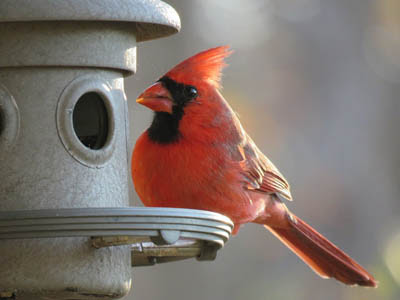 |
| Northern Cardinal. GeorgeB2 from Pixabay. |
Males of these large seed eaters are bright red with a black face and red crest.
Females replace most of the red with brown, The bill is large and orange.
These birds are found in woodlands, stream edges, residential areas.
Northern Cardinals are year-round residents throughout Delaware.
American Robin
These are familiar lawn birds with red breasts.
 |
| American Robin. Greg Gillson. |
Male American Robins are brownish-gray above with a brick red breast. Females are paler orange below and paler gray above.
They are widespread in open country with scattered deciduous trees, residential areas.
American Robins are year-round residents throughout Delaware.
House Finch
When people ask about a bird with a red head at their feeder, it is usually this bird.
 |
| Male House Finch. Greg Gillson. |
Males of this dusty brown striped finch have red limited to the head (specifically the forehead and eyebrow), breast (chest), and rump. The red coloration tends toward orangish and may rarely be yellowish.
Females are streaked, similar to the males but without red. They lack any strong pattern on the face and head.
Note the small round head and curved upper ridge on the bill.
Some people call these red-headed sparrows. Sparrows and finches are similar, but in general, male finches are brighter than the females and tend to hang out more in trees. Sparrow genders are usually quite similar in coloration and tend to feed mostly on the ground.
These birds are common in residential areas, especially at bird feeders. In the West more widespread in arid regions near water.
House Finches are year-round residents throughout Delaware.
Ruby-throated Hummingbird
These red-throated birds are the only hummingbird nesting in the eastern United States.

Males are dark green above and on the belly. They have a white upper chest. The throat is ruby-red.
Females are green above, white below, including white throat.
These birds are found in woodland edges, residential yards. Readily come to hummingbird feeders.
Ruby-throated Hummingbirds are summer residents throughout Delaware.
Scarlet Tanager
A brilliant red and black bird!
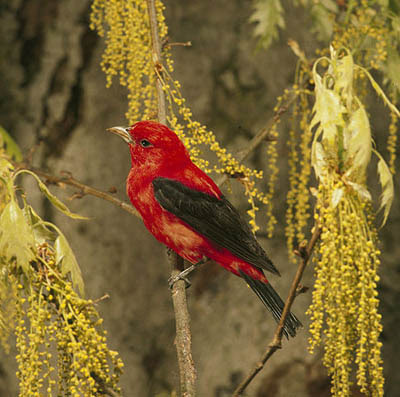 |
| Male Scarlet Tanager. USF&WS. Public Domain. |
Males are unmistakable with brilliant red with black wings and tail.
Females are olive-green above, darker wings and tail, yellower under parts. Pale bill.
These birds live in deciduous woods.
Scarlet Tanagers are summer residents throughout Delaware.
Orange birds of Delaware
True orange-colored birds are not that common. Many birds that I have here are paler rusty.
The common pattern is an orange body and black or brown wings and tail. Another common pattern is for the orange to be restricted to the under parts.
The following are orange birds that you are most likely to see in Delaware.
Eastern Towhee
These black-hooded birds with rusty-orange sides like to hide in dense bushes.
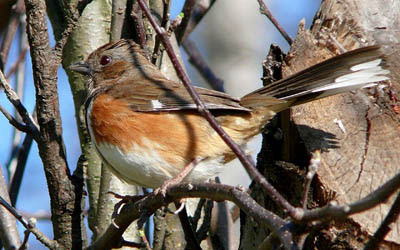 |
| Female Eastern Towhee. Skeeze. Pixabay. |
Males are black above with white wing patch, white tail corners. The sides are rusty. The belly white. Eyes variable: brown, red, orange, white, tending toward whiter southward.
Females are similar, but upper parts brown.
These birds are found in forest understory, dense brush, backyard hedges. Come to feeders.
Eastern Towhees are year-round residents throughout Delaware.
Barn Swallow
These orange-bellied birds are a familiar sight across North America in summer.
 |
| Barn Swallow. Greg Gillson. |
These birds are purple-blue above with orange under parts and long forked tails. The color of the underparts in winter or on females are often cinnamon or buff-colored, but breeding males can be brighter orange-red.
These birds swoop low over fields and wetlands at lower elevations. They may build their mud nests in rafters on porches, garages, or other out-buildings.
Barn Swallows are summer residents throughout Delaware.
Cooper’s Hawk
These crow-sized hawks with reddish orange bars on the under parts may show up in fall or winter to hunt birds at your feeder. Oh no!
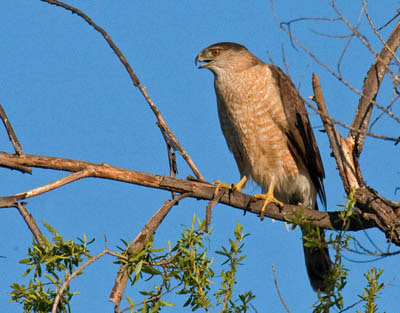 |
| Cooper’s Hawk. Greg Gillson. |
Adults with long gray and black banded tail. Dark gray above and cap on head. Under parts barred with rusty orange.
Immatures similar, brownish, streaked with brown on under parts.
Found in forests and woodlands, residential shade trees.
Cooper’s Hawks are year-round residents throughout Delaware.
Sharp-shinned Hawk
These orange-breasted woodland birds of prey are miniature versions of Cooper’s Hawks.

These small hawks are the size of jays. Adults are dark gray above with rusty orange bars on the breast. Banded tail is square-tipped, unlike the round tail tip of Cooper’s Hawks.
Immatures are browner above, with brown streaks on the under parts.
Largest female Sharp-shinned Hawks barely overlap with smallest male Cooper’s Hawk–a difficult identification challenge.
These birds are forest hunters, winter birds may be found out more in the open–but trees and brush are necessary for hunting small birds after a chase through the underbrush and foliage.
Sharp-shinned Hawks are year-round residents throughout Delaware.
American Redstart
In flight these small warblers flash orange or yellow in the wing and base of the tail.
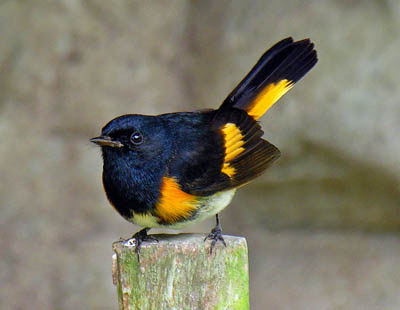 |
| American Redstart. Dennis Jarvis. Flikr. CC BY-SA 2.0 |
Males are black above, white on the belly. They have bright orange patches on side of breast, wings, and base of the tail.
Females are grayer, especially on the head. The orange of males is replaced by yellow on the females.
These birds are found in regenerating woods after a clear cut, and willow tangles along streams.
American Redstarts are summer residents throughout Delaware.
Wood Thrush
These spotted birds with the orange-brown upper parts tend to hide in understory trees and on the forest floor.
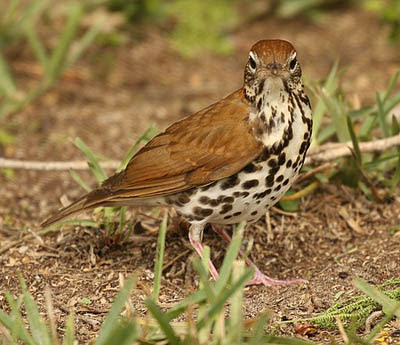 |
| Wood Thrush. Tony Castro. CC BY-SA 4.0 |
These birds are reddish brown on the upper parts, especially rusty orange on the crown and upper back. White eye ring. Large heavy black spots on the under parts.
They live in deciduous and mixed woods. Spend much time on the ground, shuffling through the leaf litter.
Wood Thrushes are summer residents throughout Delaware.
Red-shouldered Hawk
Okay, the shoulders are reddish. But the rusty-orange breast and wing linings are barred red too.
 |
| Red-shouldered Hawk. Greg Gillson. |
The upper parts are barred black and white. The tail is banded black and white. In adults the breast is barred orange.
Immature birds are streaked with brown on the breast.
These birds like woodland edges, residential edges, riparian groves.
Red-shouldered Hawks are year-round residents throughout Delaware.
American Kestrel
These are the familiar small rusty-orange falcons sitting on power lines on the edge of the highway or hunting and hovering over the median strip.
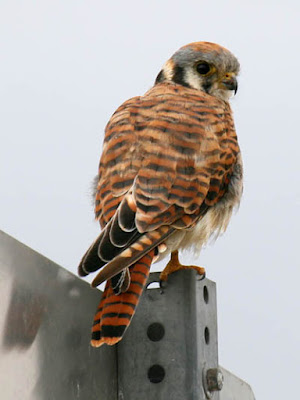 |
| Female American Kestrel. Greg Gillson. |
Females are rusty orange barred with black on their back wings and tail. The under parts are buff with black spots. The head shows two facial stripes.
Males have blue-gray backs and rufous tail is unmarked except for black tail band.
These birds are found in open country, farms, pastures with perches.
American Kestrels are year-round residents throughout Delaware.
Red-breasted Nuthatch
These active little red-breasted birds crawls all around on the trunk and big branches of conifers. They search crevices in the bark for insect food.
 |
| Red-breasted Nuthatch. Greg Gillson. |
These tiny birds have blue-gray backs and a black line through a white face. Some males can have quite bright rusty red under parts. Some females can have quite pale buff-colored under parts. Most birds show an orange-cinnamon breast color.
Found nearly exclusively in conifers. Readily come to feeders.
Red-breasted Nuthatches are winter visitors throughout Delaware.
Orchard Oriole
Males of these orioles are darker rustier orange than most other orioles in the United States.
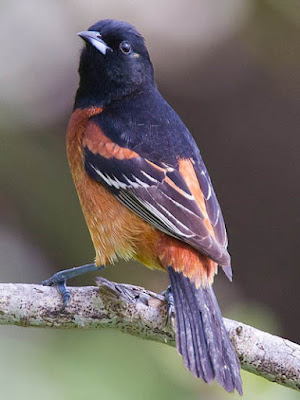 |
| Orchard Oriole. Dan Pancamo. Flikr. CC BY-SA 2.0 |
Males have a black hood and back, black wings and tail. The under parts are rusty-orange or even chestnut-brown.
Females are greenish above, lemon yellow below. They have 2 thin white wing bars. The bill is thinner than many other orioles.
They are found in orchards and residential shade trees.
Orchard Orioles are summer residents throughout Delaware.
Baltimore Oriole
These bright orange and black birds are fairly common breeders in wooded areas in the East.
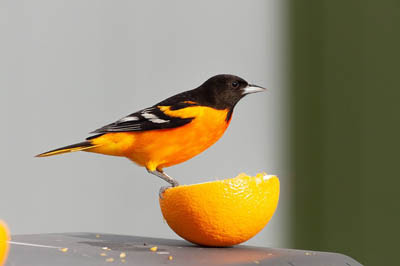 |
| Baltimore Oriole. Michael McGough. Pixabay. |
Males have a black hood and back. Wings black with white patches. Tail black with orange sides to the base. Bright orange under parts.
Females are similar to males, but more olive above, less black. Immature birds for their first year or more are olive above orangish-yellow on the breast, fading to yellow on the belly. Two white wing bars.
These birds are common in deciduous woods, shade trees.
Baltimore Orioles are summer residents throughout Delaware.
Ruddy Duck
These small ducks are dark rusty-orange in spring.
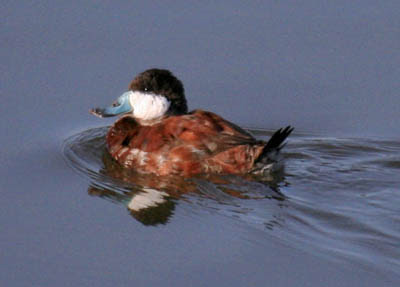 |
| Ruddy Duck. Greg Gillson. |
Males in breeding plumage (late winter and spring) are rusty, with a white face, and a blue bill. The long tail is often held sticking up. In winter they are brown, with white face, and dark bill.
Females all year are like winter males. Brown body, dark cap, dark line through eye of pale face. Dark bill.
These birds prefer weedy ponds to breed, but in winter may be found in deeper ponds in city parks.
Ruddy Ducks are winter visitors throughout Delaware.
Brown Thrasher
These are rather large rusty-orange songbirds.
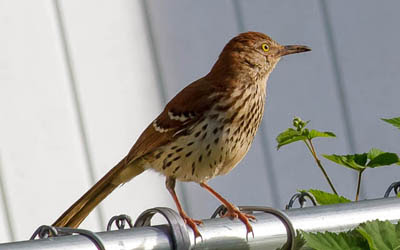 |
| Brown Thrasher. Linda Jones CC0. |
The upper parts of these birds are colored rusty-brown to orange. They show two white wing bars. Under parts are buff with heavy reddish-brown streaking.
These birds live in woodland edges and mature backyard landscaping.
Brown Thrashers are year-round residents in southern Delaware, summer residents only in northern Delaware.
Yellow birds of Delaware
Yellow is a common bird color! Often it is mixed with black and white plumage in birds.
Many birds with darker upper parts have yellow breast or belly.
The following are yellow birds you are most likely to see in Delaware.
American Goldfinch
These small little birds are bright yellow and black.
 |
| American Goldfinch. Greg Gillson. |
Males are bright lemon yellow with black and white wings and tail, black cap. White under tail coverts. Pink bill.
Females are duller yellow below and brownish above. Lack black cap.
Winter birds are pale brown or gray, a touch of yellow on the throat of males.
These are birds of open country, fields with saplings, clear cuts, residential areas. They avoid dense forests, mountains, deserts. They visit feeders.
American Goldfinches are year-round residents in Deaware.
Northern Flicker
These woodpeckers spend much time eating ants on the ground.
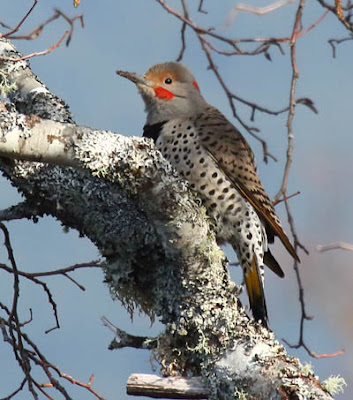 |
| Northern Flicker. Greg Gillson. |
These birds are larger than robins with brown and black barred upper parts. The underparts are pink with round black spots. There is a black crescent across the chest. When they fly away from you they reveal a large white rump.
Western birds have salmon-red under wings and under tail. Those in the East are colored yellow. The male face differs between the two populations–black whisker on the eastern birds, red whisker on western birds. Intergrades from overlap on Great Plains common. These may show male facial characteristics of both populations, or yellow-orange flight feathers.
These birds live in open woods with bare ground for foraging, residential yards.
Northern Flickers are year-round residents throughout Delaware.
Common Yellowthroat
These buttery yellow birds are abundant in the marsh vegetation.
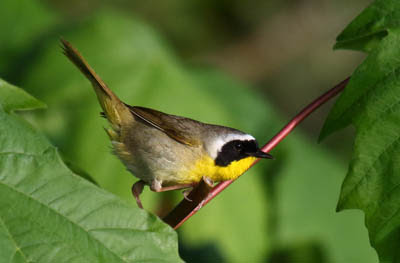 |
| Male Common Yellowthroat. Greg Gillson. |
These skulkers have bright yellow throats and yellow undertail coverts. Males have a black domino mask edged broadly in white, which females lack. Upperparts are dull olive-green.
Immature males in fall show a shadowed black mask.
Found in damp situations and heavy deciduous brambles following clear cuts.
Common Yellowthroats are summer residents throughout Delaware.
Yellow-rumped Warbler
These are abundant warblers across North America. Affectionately called “butter butts” by many birders, because of their bright yellow rumps that flash in flight.
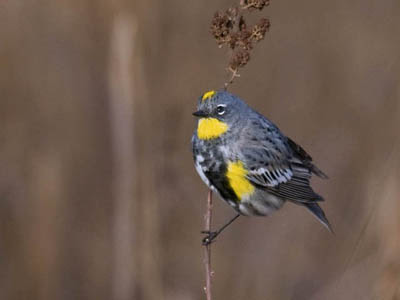 |
| Male Audubon’s Yellow-rumped Warbler. Greg Gillson. |
Western form (Audubon’s) with bright yellow throat and yellow rump. Large white wing patch.
Northern and Eastern form (Myrtle) with white throat, yellow rump, and two white wing bars.
Winter birds are dull gray-brown, with bright yellow rump. Throat may be cream colored or white. Often difficult to tell the two forms apart in winter.
 |
| Winter Yellow-rumped Warbler. Greg Gillson. |
Breed in mountain or boreal conifers. Widespread in migration. Winter in low river bottoms, open weedy deciduous areas. Rarely come to feeders in winter.
Yellow-rumped Warblers are winter visitors throughout Delaware.
Cedar Waxwing
These crested birds with yellow band on the end of the tail are often found in flocks. They eat flying insects in summer, fruit and berries the rest of the year.
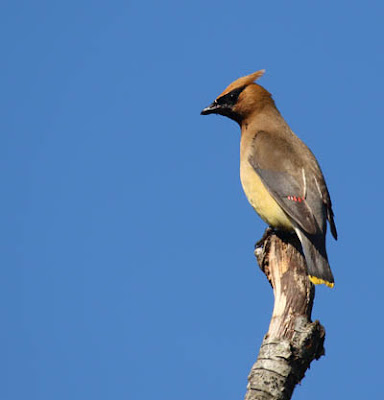 |
| Cedar Waxwing. Greg Gillson. |
These birds are fawn-brown above, with dark gray wings and tail. They have a black mask and wispy crest. The belly is yellow. The wings have waxy red drops on the end of the tertials. The end of the tail has a brilliant yellow tail band.
They are found in open habitats with berries, including juniper woodlands and towns in winter.
Cedar Waxwings are year-round residents throughout Delaware.
Great Crested Flycatcher
These flycatchers have long tails and big heads with big bill and bright yellow belly.
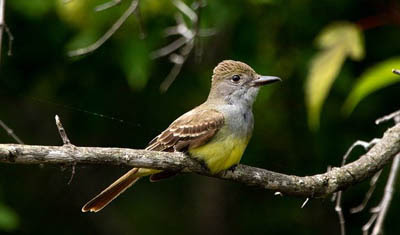 |
| Great Crested Flycatcher. Simard Francois. Pixabay. |
These birds are gray on the face and breast, brownish on rest of upper parts. Bright lemon-yellow belly. The under sides of the tail and some feathers of the wing are cinnamon colored.
These birds stay in the canopy of open woods.
Great Crested Flycatchers are summer residents throughout Delaware.
Yellow Warbler
The golden yellow sun packed all into one little bird! Appears to be an all-yellow bird.
 |
| Yellow Warbler. Greg Gillson. |
Some populations are bright yellow, some tend toward greenish on upper parts, some more golden. Yellow internal tail corners in flight.
Males with red breast streaking, again, variable by population.
Females are somewhat, to much, paler yellow, some greenish, some whitish. Lack red streaks.
These birds are found in willow thickets on the edge of wetlands and ditches, stream sides in arid regions.
Yellow Warblers are summer residents throughout Delaware.
Pine Warbler
This yellow and gray bird is one of the few warblers to visit feeders–and the only one to eat seeds!
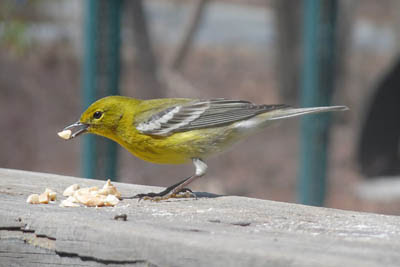 |
| Pine Warbler. Nikolaus Schultz. Pixabay. |
These birds are yellow-green on head, back, and breast. Wings blue-gray with wide white wing bars. Yellow split eye ring.
Strongly associated with pine forests. Usually high in treetops.
Pine Warblers are summer residents throughout Deleware.
Yellow-breasted Chat
These unique larger yellow birds may sing day and night, and include whistles and crow-like cawing, often given in a display flight.
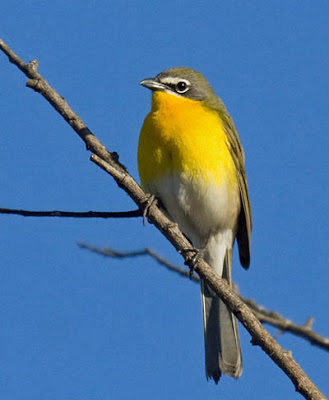 |
| Yellow-breasted Chat. Greg Gillson. |
These birds are greenish above with bright yellow breast and white belly. They have a dark mask bordered with white.
These birds live in tangles and wet woods.
Yellow-breasted Chats are summer residents throughout Delaware.
Wrapping Up
Delaware boasts a diverse selection of colorful birds but there are also many black and white ones, offering opportunities for exciting birdwatching throughout the year. Here are some common and notable choices:
- Downy Woodpecker: This small, energetic woodpecker features black and white stripes on its head and back, with a red dot on the male’s head. Look for them drumming on trees and searching for insects in woods, parks, and even backyards.
- Black-Capped Chickadee: These charming and acrobatic birds have a black cap, white cheeks, and a black bib. They flit through trees and shrubs, offering cheerful “chick-a-dee-dee” calls.
- White-Breasted Nuthatch: This unique climber navigates tree trunks headfirst, sporting a black cap, white breast, and gray back. They readily visit bird feeders for suet and nuts.
- Dark-Eyed Junco: Primarily gray with white underparts and black wings, these ground-dwelling birds are common near brush and forest edges. Their sweet trilling song adds to the winter melody.
- Black-and-White Warbler: True to its name, this striking warbler boasts black and white stripes on its entire body. Look for them in mature forests, flitting through the understory and catching insects.
Frequently Asked Questions
When is the Ruby-throated Hummingbird present in Delaware?
Ruby-throated Hummingbirds are not year-round residents in Delaware. They are migratory birds, arriving in the state during the spring and summer months and leaving for their wintering grounds in Central America when the weather turns colder. Here’s a breakdown of their migratory timeline in Delaware:
Arrival:
- Mid-April: This is the typical starting point for their arrival in Delaware. Males tend to arrive first to establish territories, followed by females soon after.
- Weather fluctuations: Depending on weather conditions, their arrival date can vary slightly. Warmer springs might see them arrive earlier, while colder ones could delay their migration.
Presence:
- Spring and Summer: They spend their breeding season in Delaware, building nests, raising young, and enjoying the abundance of nectar-producing flowers.
- Peak activity: Late spring and early summer are generally considered the peak time to see Ruby-throated Hummingbirds in Delaware, as they’re actively breeding and feeding their young.
Departure:
- September and October: As fall approaches and days shorten, they begin their southward migration to their wintering grounds.
- Late October: By the end of October, most Ruby-throated Hummingbirds have left Delaware for their warmer southern habitat.
What kind of bird has an orange beak in Delaware?
Delaware boasts a diverse bird population, and several species sport orange beaks! To narrow down your search, it would be helpful to know additional details about the bird you saw, such as:
Size: Was it a small, medium, or large bird? Shape: Did it have a long, slender beak, a short and thick beak, or something else? Other noticeable features: Did it have any specific markings on its body, wings, or tail? Was it singing or making any particular sounds?
With more information, I can provide a more accurate list of potential bird species with orange beaks in Delaware. However, here are some general possibilities:
- Northern Cardinal: Male cardinals have vibrant red plumage and bright orange beaks.
- American Oystercatcher: These shorebirds have long, thick, reddish-orange beaks.
- Baltimore Oriole: Males have black bodies, orange chests, and orange-tinged beaks.
- Common Yellowthroat: Males have black faces, yellow throats, and olive plumage with orange-ish beaks.
- Yellow-bellied Sapsucker: This woodpecker has a black and white patterned body, a red patch on the head, and a yellow belly with an orange-tinged beak.
Where can I find the White-eyed Vireo in Delaware?
Finding the White-eyed Vireo in Delaware requires knowing their preferred habitat and timing your visit right. Here’s what you need to know:
Habitat:
- White-eyed Vireos prefer dense shrubbery and thickets at the edges of woodlands, forests, and swamps. They also favor areas with second-growth forests and overgrown fields.
- Look for them in areas with plenty of vegetation close to the ground, as they tend to forage and nest in the understory.
Timing:
- White-eyed Vireos are migratory birds, spending their breeding season in the eastern United States before heading south for the winter.
- In Delaware, they typically arrive in mid-April and stay until late September or early October.
- Peak season for sighting them is May through July, when they’re actively breeding and singing.
Specific Locations:
- White-eyed Vireos can be found throughout Delaware, but some good places to start your search include:
- Bombay Hook National Wildlife Refuge: Offers diverse habitats, including marshes, forests, and thickets.
- Trap Pond State Park: Provides a variety of wooded areas and shrublands.
- White Clay Creek State Park: Features mature forests and open fields with brushy edges.
- Delaware Seashore State Parks: The coastal forests and shrublands can attract these birds.
- Nature preserves and wildlife refuges across the state, offering suitable habitat.
Related Articles:
See photos and learn about the most common backyard birds in Delaware, regardless of color.
Birds at Your Feeder in Delaware
Here’s a quick tutorial of how I would teach you to identify birds: 7 Steps to Identify Birds!
Birds with red heads in North America.
Yellow-and-black birds in North America.
Little Brown Birds at your Feeder.










